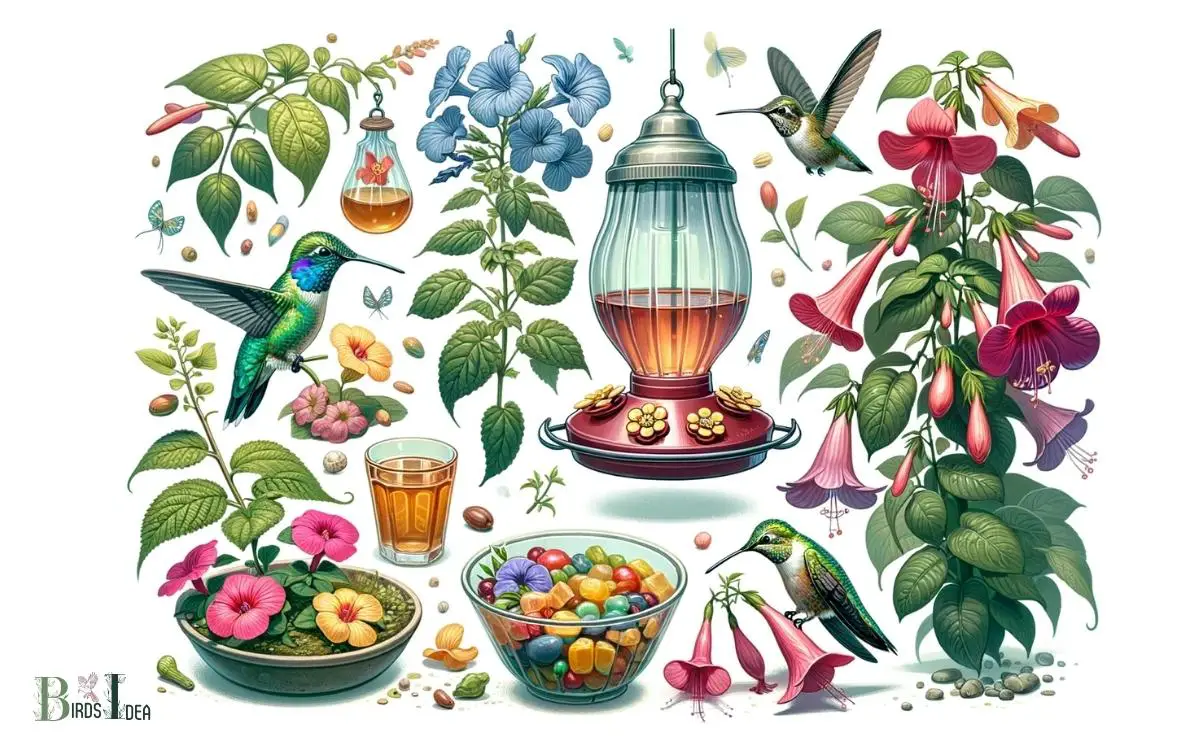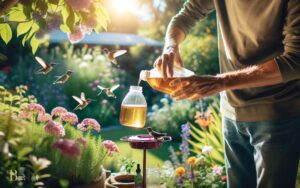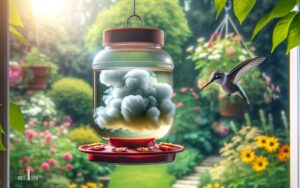What to Feed a Hummingbird? Discover!
To feed a hummingbird, provide homemade sugar water (a mixture of one part white sugar to four parts water), avoid red dye, and ensure feeders are clean.
Additionally, plant native flowers that produce nectar and avoid pesticides in your garden to support a healthy diet for hummingbirds.
Hummingbirds primarily feed on nectar from flowers, which provides them with the necessary energy.
They also eat small insects and spiders for protein. When natural food sources are scarce, hummingbirds can be supported with artificial nectar made from a simple sugar solution.
Here are the key points for feeding hummingbirds:
Ensure a safe haven for hummingbirds by offering nutritious nectar and fostering a pesticide-free garden environment.

Key Takeaway
Natural Nectar Sources
Discussing natural nectar sources for hummingbirds, it is important to consider the variety of flowers that produce suitable nectar for these tiny birds.
Hummingbirds are attracted to flowers with tubular shapes, bright colors such as red, orange, and pink, and a high concentration of sucrose in their nectar.
Some popular natural nectar sources for hummingbirds include trumpet vine, bee balm, salvia, and penstemon.
These flowers not only provide a rich source of nectar but also offer a safe and natural environment for hummingbirds to feed.
When selecting natural nectar sources for hummingbirds, it is essential to prioritize native plants that are adapted to the local climate and require minimal maintenance.
By cultivating these natural nectar sources, individuals can contribute to the well-being and conservation of these delightful birds.
Insect Protein
Hummingbirds require a significant amount of insect protein in their diet to supplement their energy needs and provide essential nutrients for their physiological functions. Insect protein is crucial for their growth, feather development, and overall health.
To ensure that these magnificent creatures are adequately nourished, consider the following:
- Providing a diverse array of insects will offer a balanced diet and cater to their varying nutritional requirements.
- Cultivating a hummingbird-friendly garden with an abundance of insect-attracting plants can help sustain their natural food sources.
- Supporting conservation efforts to protect insect populations will ultimately benefit the well-being of hummingbirds, ensuring they have an ample supply of protein-rich prey.
Artificial Nectar Options
When considering artificial nectar options for feeding hummingbirds, it’s essential to explore sugar water alternatives and natural nectar sources.
It’s crucial to take into account the health considerations for hummingbirds when choosing the type of artificial nectar to provide. These points will help ensure that the hummingbirds receive a suitable and nutritious diet.
Sugar Water Alternatives
Artificial nectar options provide a suitable alternative to sugar water for hummingbirds. While sugar water is a popular choice, some individuals may prefer to provide artificial nectar options due to various reasons such as health concerns, dietary restrictions, or personal preferences.
When serving hummingbirds, it’s important to consider their well-being and provide alternatives that cater to their needs.
Here are three artificial nectar options to consider:
- Organic nectar: Opting for organic nectar ensures that the hummingbirds are consuming a natural and chemical-free alternative.
- Plant-based nectar: Choosing plant-based nectar options allows hummingbirds to enjoy a diverse range of flavors and nutrients, similar to what they would find in nature.
- Non-GMO nectar: Providing non-GMO nectar options can give peace of mind to those who seek to offer the best quality of food for these beautiful creatures.
These options can provide a more diverse and nutritious diet for hummingbirds. However, it’s important to ensure that any artificial nectar options closely mimic the nutritional content of natural sources.
Considering health considerations for hummingbirds, it’s crucial to assess the nutritional value and potential impact on their well-being when choosing a nectar source.
Health Considerations for Hummingbirds
Considering the importance of mimicking the nutritional content of natural sources, it is essential to carefully evaluate the nutritional value and potential impact on the well-being of hummingbirds when selecting artificial nectar options.
When choosing artificial nectar for hummingbirds, it’s important to consider:
- Nutritional Balance: Ensure that the artificial nectar provides the necessary nutrients, such as sucrose, to support the hummingbirds’ energy requirements and overall health.
- Avoiding Harmful Additives: Opt for artificial nectar options that are free from harmful additives, preservatives, or artificial colors, which could negatively affect the well-being of hummingbirds.
- Ease of Digestion: Select nectar that is easily digestible and closely resembles the viscosity of natural floral nectar to prevent digestive issues and support the hummingbirds’ dietary needs.
Seasonal Feeding Considerations
To ensure the consistent well-being of hummingbirds, it is crucial to take into account the seasonal variations when determining their feeding regimen.
Hummingbirds’ dietary needs change with the seasons, and it’s important to adjust their feeding schedule and offerings accordingly.
In the table below, you will find a seasonal feeding guide to help you understand the changing needs of hummingbirds throughout the year.
| Season | Feeding Recommendations |
|---|---|
| Spring | Increase nectar offerings as flowers bloom |
| Summer | Provide a variety of insects and nectar |
| Fall | Offer high-energy foods for migration |
| Winter | Maintain year-round nectar feeders |
Additional Feeding Tips
When it comes to feeding hummingbirds, there are several additional tips to consider for their well-being.
Proper hummingbird feeder placement, ensuring fresh nectar preparation, and avoiding the use of red dyes are crucial aspects of maintaining a healthy feeding environment for these tiny birds.
These points will be further explored to provide comprehensive guidance on additional feeding considerations for hummingbirds.
Hummingbird Feeder Placement
Place the hummingbird feeder approximately 10 to 15 feet from any windows to reduce the risk of bird collisions. This will help to ensure the safety of these delicate creatures while they feed.
When selecting a location for your feeder, keep the following points in mind:
- Choose a spot with some overhead cover, such as a tree branch or an awning, to provide the hummingbirds with protection from predators and shelter from the elements.
- Position the feeder near flowers or plants that hummingbirds are naturally attracted to, creating a welcoming environment that encourages their visits.
- Place the feeder in an area where you can easily observe and enjoy these beautiful birds, allowing you to appreciate their presence and the joy they bring to your surroundings.
After carefully considering the feeder placement, it’s essential to understand the importance of fresh nectar preparation.
Fresh Nectar Preparation
Fresh nectar preparation is essential for ensuring the proper nourishment of hummingbirds in your care.
To prepare fresh nectar, mix one part plain white granulated sugar with four parts water. Boil the water if there are any concerns about its purity, then stir in the sugar until it dissolves.
Allow the solution to cool before filling the feeder. It’s crucial to change the nectar every two to three days, even if it hasn’t been fully consumed, as it can ferment and harm the hummingbirds.
During hot weather, consider changing it daily. Additionally, avoid using honey, artificial sweeteners, or red food coloring, as these can be harmful to the birds.
By following these guidelines, you can ensure the hummingbirds receive the best care and nourishment.
Avoiding Red Dyes
To ensure the health and well-being of hummingbirds, it is important to avoid using red dyes in their nectar, as these can be harmful to the birds.
Red dyes may contain chemicals that can have adverse effects on hummingbirds’ delicate systems.
Instead, consider the following tips for providing safe and nutritious nectar:
- Offer natural nectar alternatives, such as homemade sugar water, to avoid exposing hummingbirds to potentially harmful substances.
- Choose feeders with vibrant red coloring or other attracting features to catch the attention of hummingbirds without the need for artificial dyes.
- Educate others about the dangers of using red dyes in hummingbird nectar, promoting the well-being of these remarkable creatures and fostering a community dedicated to their care.
What’s the Best Hummingbird Food?
The best hummingbird food is a simple solution that mimics the natural nectar they obtain from flowers.
You can make hummingbird food at home with a mixture of four parts water to one part white granulated sugar.
It’s important to use plain white granulated sugar, as other sweeteners or sugar substitutes can be harmful to hummingbirds.
To make hummingbird food:
- Boil water to remove impurities.
- Mix four parts boiled water with one part white granulated sugar.
- Stir until the sugar is completely dissolved.
- Let the mixture cool to room temperature before filling your hummingbird feeder.
It’s crucial to clean your hummingbird feeder regularly (at least every few days) to prevent the growth of harmful mold and bacteria.
Avoid using red food coloring or honey, as they can be harmful to hummingbirds. Stick to the simple sugar-water solution for the health and well-being of these tiny birds.
What Food Options Should I Consider for Feeding Hummingbirds?
When it comes to feeding hummingbirds, it is important to provide them with the right food options. One option to consider is to buy hummingbird food. This specialized type of food is designed to provide the essential nutrients that hummingbirds need. It is important to choose a food that is free from artificial dyes and flavors, as these can be harmful to the birds. Additionally, opting for a liquid concentrate or nectar mix can make it easier to prepare and fill hummingbird feeders. Remember to clean the feeders regularly and replace the food every few days to ensure the health and well-being of these beautiful creatures.
How Long is Sugar Water Good for Hummingbirds?
Hummingbird feeders should be cleaned and refilled regularly to ensure the health and well-being of the hummingbirds.
The sugar water (nectar) in hummingbird feeders can spoil or ferment, especially in warm weather.
Here are some general guidelines:
- Frequency of Changing: In warm weather, it’s recommended to change the sugar water every 2 to 3 days to prevent fermentation and the growth of harmful molds or bacteria. In cooler weather, you can extend this to about a week.
- Cleaning: Clean the feeder thoroughly each time you refill it. Use a solution of one part white vinegar to four parts water for cleaning. Rinse the feeder well with hot water after using the vinegar solution.
- Avoid Direct Sunlight: Place the feeder in a shaded area to slow down the growth of bacteria and prevent the sugar water from spoiling too quickly.
- Monitor the Nectar: Keep an eye on the nectar for any signs of cloudiness, discoloration, or debris. If you notice any of these signs, it’s time to clean and refill the feeder.
- Seasonal Changes: During peak hummingbird season, when the birds are more active and consuming more nectar, you may need to refill the feeder more frequently.
Always use a solution of four parts water to one part white granulated sugar for the nectar. Do not use honey, artificial sweeteners, or red food coloring, as these can be harmful to hummingbirds.
By following these guidelines and regularly maintaining the feeder, you’ll help ensure that the sugar water remains fresh and safe for hummingbirds to consume.
Conclusion
Providing the right food for hummingbirds is essential for their health and well-being. Natural nectar sources and insect protein are important components of their diet, and artificial nectar options can be used as well.
Proper feeder placement and regular cleaning are crucial for attracting and maintaining hummingbirds.
Consider seasonal feeding considerations and follow additional feeding tips to ensure a thriving hummingbird population in your area.






